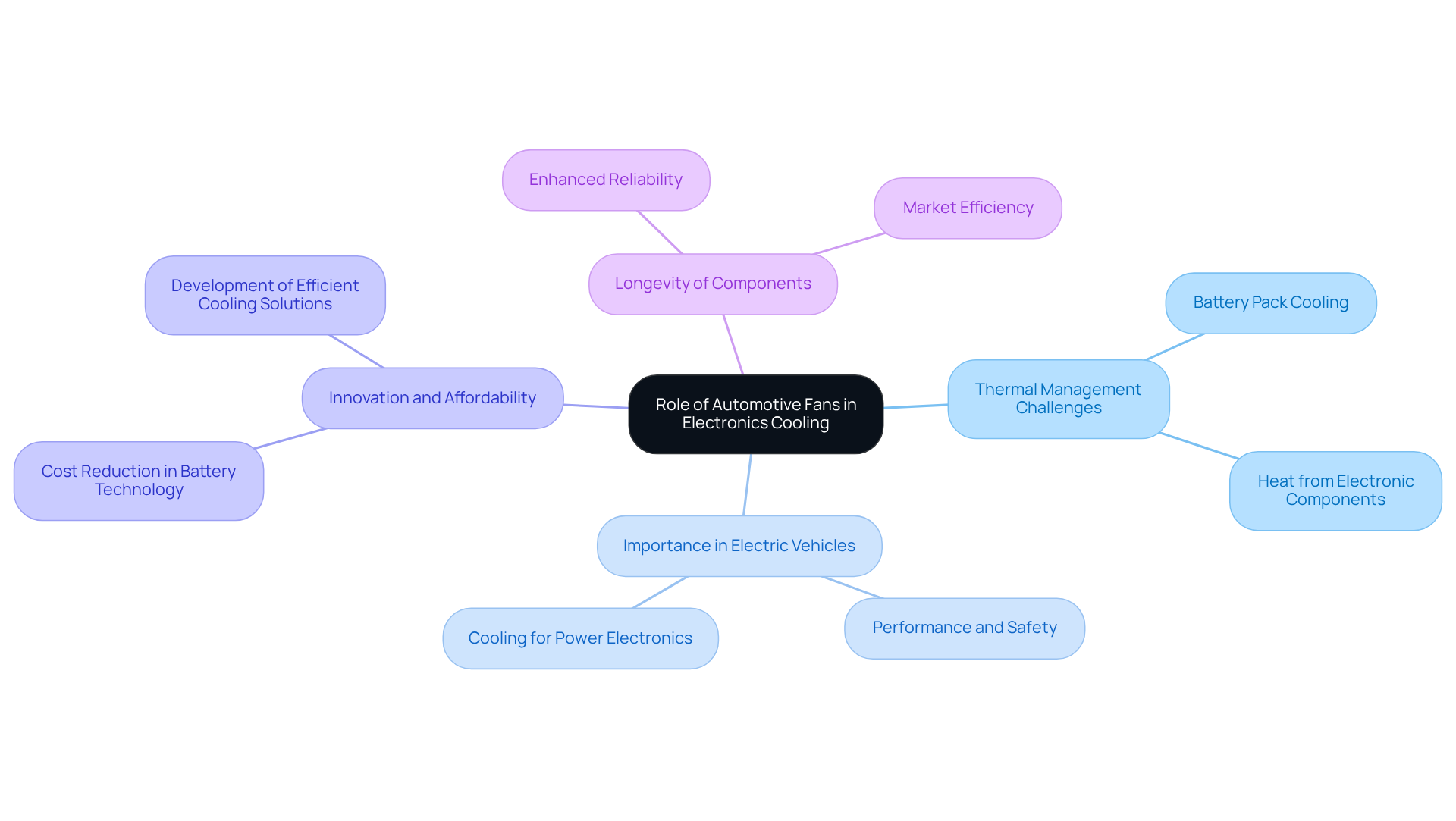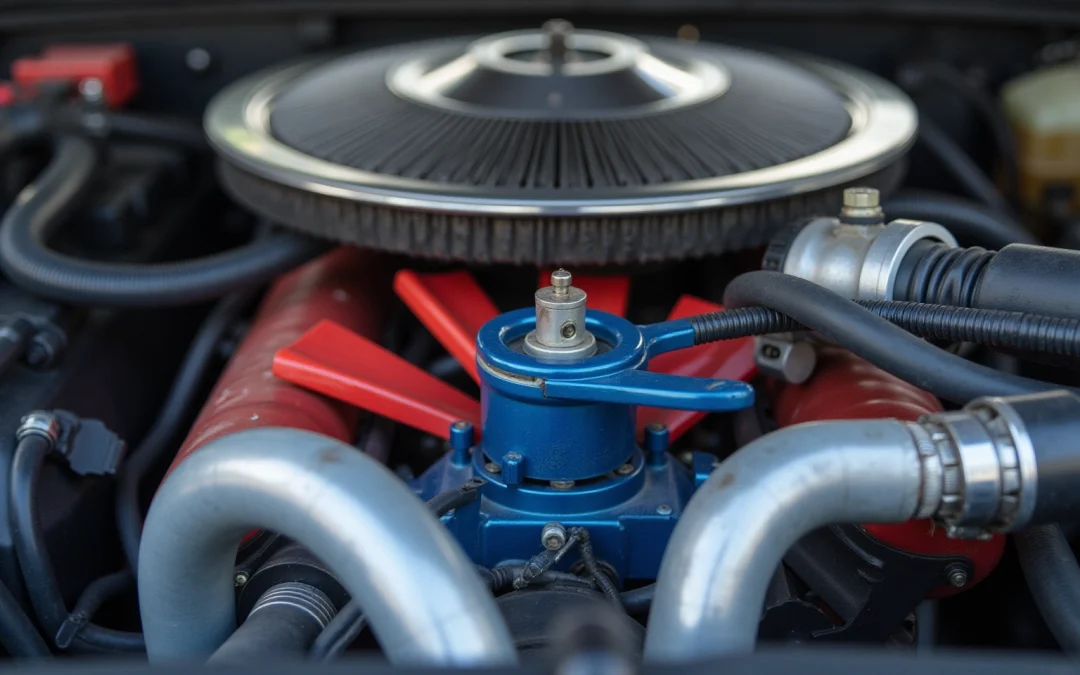Overview
Automotive fans are indispensable components within vehicle cooling systems, playing a critical role in dissipating heat from the engine and ensuring optimal temperatures to avert overheating. Their significance is underscored by the variety of fan types available—mechanical and electric—and the increasing market demand for these essential devices. Furthermore, automotive fans are pivotal in managing the thermal environment of the increasingly sophisticated electronic systems found in modern vehicles, which are designed to enhance performance and efficiency.
Introduction
Automotive fans, often overlooked components, play a pivotal role in ensuring vehicle performance and longevity. As the automotive industry advances towards increasingly complex electronic systems, the demand for efficient cooling mechanisms has never been more critical. This article delves into the essential functions of automotive fans, exploring their evolution, types, and the significant impact they have on both engine cooling and the thermal management of electronic components. How can these seemingly simple devices support the technological innovations driving the future of transportation?
Define Automotive Fans: Essential Components in Cooling Systems
Fans automotive play a crucial role in vehicle performance, functioning as essential mechanical devices that generate airflow to cool the engine and other vital components. By drawing air through the radiator, these fans facilitate the dissipation of heat from the engine coolant, a process that is critical for maintaining optimal engine temperatures and preventing overheating. The fans automotive market is projected to experience significant growth, with a forecasted increase from $52 billion in 2022 to $64.14 billion by 2028, reflecting a compound annual growth rate (CAGR) of 3.7%. This growth underscores the importance of efficient temperature control systems in modern automobiles.
Automotive fans can be categorized into two main types:
- Mechanical fans, which are directly driven by the engine.
- Electric fans, powered by the vehicle’s electrical system.
Mechanical fans are typically more durable and provide steady airflow, while electric fans offer versatility and effectiveness, particularly in vehicles with advanced temperature regulation requirements. Each type presents unique advantages based on the vehicle’s design and temperature management needs.
Case studies further illustrate the importance of fan performance in automotive applications. For example, an analysis of a ventilator’s performance revealed a baseline airflow of 842 feet per minute, which proved inadequate for optimal engine temperature regulation. This finding prompted further investigation into design variables, resulting in enhancements that , surpassing the necessary threshold. Such improvements are vital, ensuring that automobiles can operate efficiently under a variety of driving conditions.
Insights from vehicle engineers emphasize the critical function of ventilators in car temperature regulation, highlighting their impact on engine efficiency and longevity. As the automotive sector evolves, the demand for innovative temperature control solutions continues to rise, highlighting the importance of fans automotive now more than ever.

Contextualize the Role of Automotive Fans in Electronics Cooling
In the realm of electronics temperature regulation, automotive fans play a crucial role in managing the thermal environment of various electronic components, including control units, sensors, and infotainment systems. As automobiles become increasingly technologically advanced, the heat produced by these components rises, necessitating efficient cooling solutions.
For instance, consider a 100-kWh battery pack that weighs over 800 lbs—this underscores the significant thermal management challenges faced in electric transport. Fans automotive are essential in maintaining optimal operating temperatures, ensuring that electronic systems function reliably and efficiently. This is particularly critical in electric and hybrid modes of transport, where the and power electronics is vital for both performance and safety.
Tim Grewe, director of electrification strategy for GM, emphasizes the need for efficient development and innovation in this sector, stating, “Affordability remains an issue in transitioning the industry to these new models.”
Furthermore, integrating robust cooling solutions not only enhances the longevity of electronic components but also ensures that vehicles meet the increasing demands for efficiency and reliability in a competitive market. The importance of continuous operation in cell factories cannot be overstated; it is essential for efficiency and cost management, as highlighted by industry experts.
Overall, the function of fans automotive, particularly vehicle blowers in thermal management, is paramount for the effective transition to electric mobility.

Trace the Evolution of Automotive Fans: From Concept to Modern Applications
The evolution of automotive blowers has undergone remarkable technological advancements. Initially, mechanical blowers dominated the landscape, relying on engine power for operation. However, the late 20th century witnessed the rise of electric devices, which significantly enhanced efficiency and control in vehicle cooling systems.
Contemporary electric devices are designed to modify their speed based on temperature requirements, enhancing airflow while reducing energy usage. For instance, electronically commutated (EC) units have transformed performance by providing quieter operation and improved thermal management. These devices can attain , making them a favored option in energy-sensitive applications. Notably, EC motors can be up to 30% more efficient than traditional AC motors, highlighting significant advancements in fan technology.
As vehicle technology advances, the incorporation of intelligent technologies and sophisticated materials is anticipated to further change the function of blowers in cooling systems, ensuring they meet the rising requirements for efficiency and performance in automotive fans. Experts in vehicle technology emphasize that these advancements are crucial for meeting stringent energy efficiency standards and enhancing overall performance.

Identify Key Features and Specifications of Automotive Fans
Key features and specifications of automotive blowers encompass several critical factors, including:
- Airflow capacity—measured in cubic feet per minute (CFM)
- Diameter
- Motor type (brushless or brushed)
- Noise levels (measured in decibels)
The design of the fan blades significantly influences both airflow efficiency and noise generation. For instance, axial fans excel in moving large volumes of air, making them ideal for low-pressure applications, while centrifugal fans are favored in scenarios requiring higher pressure. Engineers must carefully consider these specifications to select the most appropriate fan for particular ventilation applications in vehicles.
Moreover, optimal fan performance is often linked to maintaining a tip clearance of approximately 1.13-1.5 percent of the fan diameter. This clearance is crucial for ensuring effective airflow and cooling efficiency. Understanding these parameters is essential for achieving reliable in fans automotive systems, ultimately enhancing vehicle performance and comfort.

Conclusion
Automotive fans are integral to the effective cooling of vehicles, playing a vital role in maintaining optimal engine temperatures and ensuring the reliability of electronic components. As technology advances, the significance of these fans only grows, underscoring their importance in both traditional and electric vehicles. Their ability to regulate heat not only enhances performance but also contributes to the longevity of critical systems within the automobile.
The article delves into various aspects of automotive fans, including their types—mechanical and electric—and the advancements that have transformed their functionality. Key insights highlight the necessity of efficient airflow, the evolution of fan technology, and the specifications that dictate their performance. With the automotive market projected to expand significantly, the role of fans in managing heat and ensuring vehicle efficiency is more crucial than ever.
Recognizing the importance of automotive fans is essential for anyone involved in vehicle design, maintenance, or innovation. As the industry moves towards more advanced and efficient technologies, prioritizing effective thermal management solutions will be key to meeting the demands of modern transportation. Investing in high-quality automotive fans not only supports optimal vehicle operation but also aligns with the broader goals of sustainability and efficiency in the automotive sector.
Frequently Asked Questions
What is the role of automotive fans in vehicles?
Automotive fans are essential components that generate airflow to cool the engine and other vital components by drawing air through the radiator, facilitating the dissipation of heat from the engine coolant.
What is the projected growth of the automotive fans market?
The automotive fans market is projected to grow from $52 billion in 2022 to $64.14 billion by 2028, reflecting a compound annual growth rate (CAGR) of 3.7%.
What are the two main types of automotive fans?
The two main types of automotive fans are mechanical fans, which are directly driven by the engine, and electric fans, which are powered by the vehicle’s electrical system.
What are the advantages of mechanical fans compared to electric fans?
Mechanical fans are typically more durable and provide steady airflow, while electric fans offer versatility and effectiveness, especially in vehicles with advanced temperature regulation requirements.
Why is fan performance important in automotive applications?
Fan performance is critical for optimal engine temperature regulation. Inadequate airflow can lead to overheating, and improvements in fan design can enhance airflow, ensuring efficient operation under various driving conditions.
How do automotive fans impact engine efficiency and longevity?
Automotive fans play a critical role in regulating car temperature, which directly affects engine efficiency and longevity by preventing overheating and maintaining optimal operating conditions.
What is the significance of innovative temperature control solutions in the automotive sector?
As the automotive sector evolves, the demand for innovative temperature control solutions is increasing, highlighting the growing importance of automotive fans in ensuring vehicle performance and reliability.

